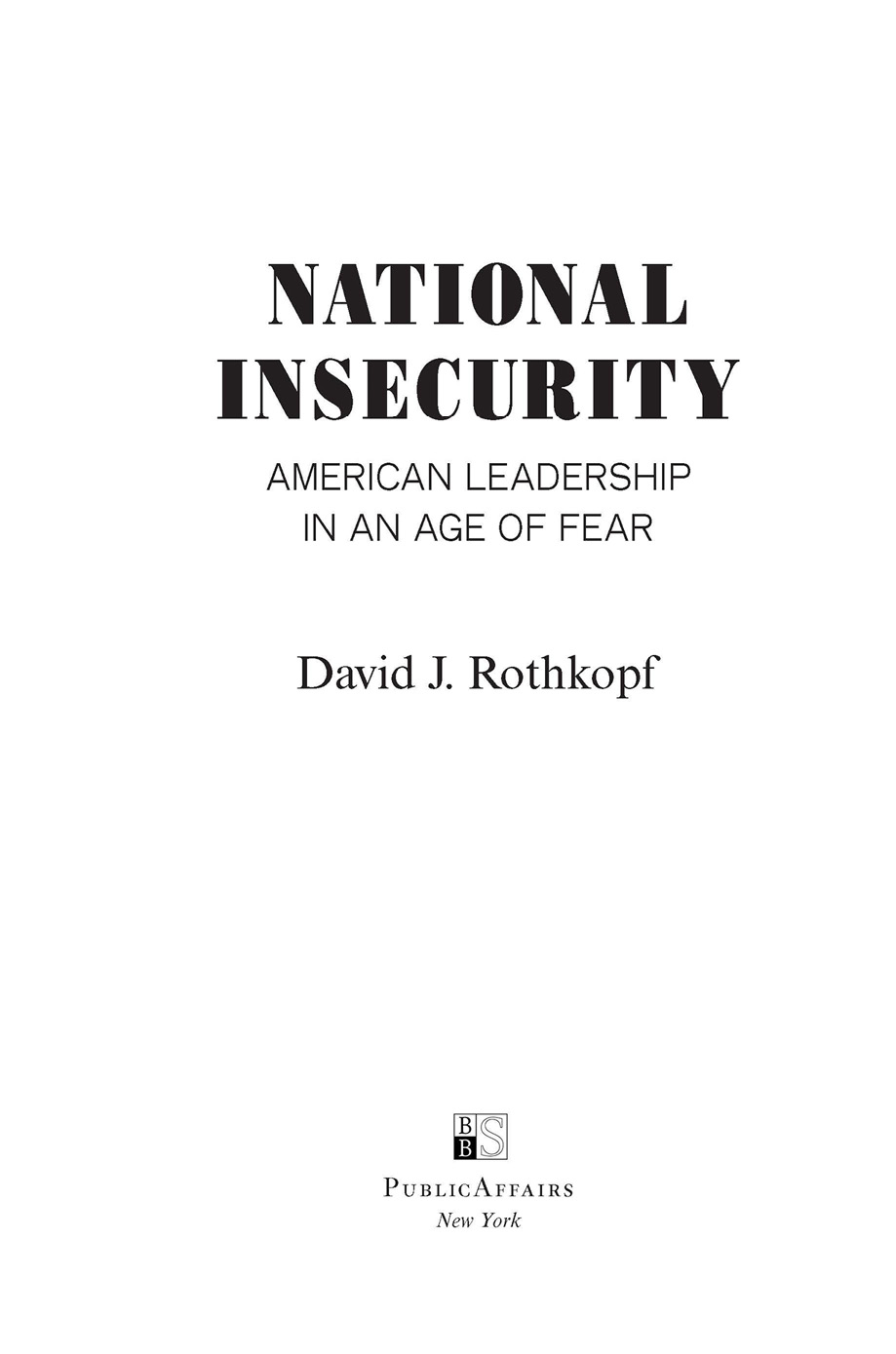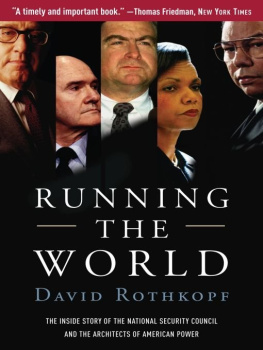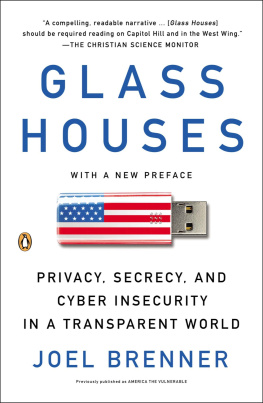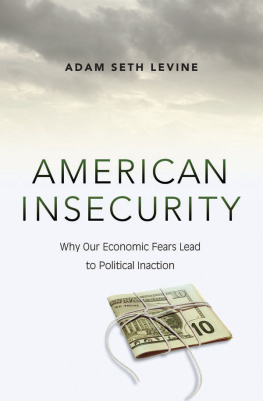ALSO BY DAVID J. ROTHKOPF
Power, Inc.: The Epic Rivalry Between Big Business and Government and the Reckoning That Lies Ahead
Superclass: The Global Power Elite and the World They Are Making
Running the World: The Inside Story of the National Security Council and the Architects of American Power
Cuba: The Contours of Change (coauthor and coeditor with Susan Kaufman Purcell)
The Price of Peace: Emergency Economic Intervention and US Foreign Policy
The Big Emerging Markets (editor and principal author)
The Common Market (coauthor with Carol Zeman Rothkopf)

Copyright 2014 by David J. Rothkopf.
Published in the United States by PublicAffairs,
a Member of the Perseus Books Group
All rights reserved.
Printed in the United States of America.
No part of this book may be reproduced in any manner whatsoever without written permission except in the case of brief quotations embodied in critical articles and reviews. For information, address PublicAffairs, 250 West 57th Street, 15th Floor, New York, NY 10107.
PublicAffairs books are available at special discounts for bulk purchases in the U.S. by corporations, institutions, and other organizations. For more information, please contact the Special Markets Department at the Perseus Books Group, 2300 Chestnut Street, Suite 200, Philadelphia, PA 19103, call (800) 810-4145, ext. 5000, or e-mail .
Book Design by Cynthia Young
Library of Congress Cataloging-in-Publication Data
Rothkopf, David J. (David Jochanan), 1955
National insecurity : American leadership in an age of fear / David Rothkopf.
First edition.
pages cm
Includes bibliographical references and index.
ISBN 978-1-61039-341-6 (e-book)
1. United StatesForeign relationsHistory21st century.
2. National securityUnited StatesHistory21st century. I. Title.
E744.R84 2014
355.033073dc23
2014021345
First Edition
10 9 8 7 6 5 4 3 2 1
For Adrean, the most fearless person I know,
With love
America is a great power possessed of tremendous military might and a wide-ranging economy, but all this is built on an unstable foundation which can be targeted with special attention to its obvious weak spots. If America is hit in one hundredth of those weak spots, God willing, it will stumble, wither away and relinquish world leadership.
OSAMA BIN LADEN
At what point then is the approach of danger to be expected? I answer, if it ever reach us, it must spring up amongst us. It cannot come from abroad. If destruction be our lot, we must ourselves be its author and finisher. As a nation of freemen, we must live through all time, or die by suicide.
ABRAHAM LINCOLN
Carrie: Im just making sure we dont get hit again.
Saul: Well, Im glad somebodys looking out for the country, Carrie,
Carrie: Im serious. I, I missed something once before. I wont, I cant, let that happen again.
Saul: It was ten years ago. Everybody missed something that day.
HOMELAND, SEASON 1, 2011
M idway through the second decade of the twenty-first century, America faces a world in turmoil. We are uncertain of our place in that world and of what role we are to play going forward.
For all of our native confidence and fundamental optimism, we have spent much of the past decade shaken and unsteady. Many of the events that created these circumstances have origins far outside Americas borders. Some, though, are of our own making. Faced with not one but two major crises and their aftershocks, our leaders responded at times with actions that put us or our interests in greater jeopardy. If we are to fully recover, we have to ask what went wrong. We also must try to understand where we made gains, and why.
Doing so requires a closer look at our leaders. It requires the discipline to set aside politics and the reflexive reactions it breeds. It demands a willingness to see our presidents and their senior advisors in their totality, the good and the bad, to know that those who blunder one day can make major contributions the next. And because so much of what happens in the American system and the world happens within the closely knit, often opaque world immediately around the President of the United States, it requires a concerted effort to pull back the curtain and truly understand what is going on in that rarified environment.
Exploring this vantage point makes it possible to take a story that seems very familiarthat of the past decade, of Presidents Bush and Obama, of Iraq, Afghanistan, terror, financial crisis, and the rise of new powersand to see it in an entirely new and often unexpected way. We can then come to see how the forces that have over the past few decades led us to concentrate more and more power within the White House may be as responsible for many of the challenges we have faced as any individual or distant event. In the same way, it becomes possible to understand that very often what goes on behind the scenes, from personality struggles to issues of character, from the choices presidents make as managers, as chief executives , to the processes by which they reach decisions as commanders-in-chief, can be as important to preserving and advancing Americas interests as all the speeches and summit meetings, the high-profile actions of our leaders that we are more accustomed to seeing on the news or reading about on the Internet.
This book is an effort to tell that story, to give the reader a glimpse into what it was like in the innermost circles of American power at a moment of unprecedented challenges, a moment in which America felt more vulnerable and adrift than at any time in modern memory, and to draw concrete lessons from this period for rejuvenating US global leadership in a rapidly changing world.
***
The war that began for America on the morning of September 11, 2001, was the first in the countrys history that began with an image. It was a scene that within hours of taking place was almost universally observed.
In the past, wars were triggered by actions that were reported in dispatches, recounted in newspapers, described in speecheswhether before the Congress, in local meeting halls, or on radio or television. They were presented in prose, couched in arguments that, even when infused with emotion, appealed to citizens through their intellects. Yes, populists and demagogues and newspaper publishers sought to tug at heartstrings and stir anger, but the path to these reactions always traveled through the mind before it reached human hearts.
The gallery of images presented on the morning of al-Qaedas attacks on the World Trade Center and the Pentagon was something else again. Jetliners piercing the glistening glass skin of towers that had been targeted precisely because they were longstanding symbols of American vibrancy and strength. Another plane smashing into the side of the headquarters of our military. Desperate souls, tiny silhouetted dolls, plunging helplessly, horrifyingly, to their deaths rather than face incineration in the jet-fuel-fed fires that melted the Trade Center from within. And then, ultimately, the indelible, unthinkable sight of the crumbling towers, seemingly consumed by great steel-grey clouds of dust and rubble.
As the crowds ran from the disaster, pursued by those almost demonic clouds snaking through the streets of lower Manhattan, what we saw on their faces we felt in our hearts. There was no need for words. Indeed, commentators were left speechless. We were shaken. We were made afraid. We could hardly believe our eyes.









